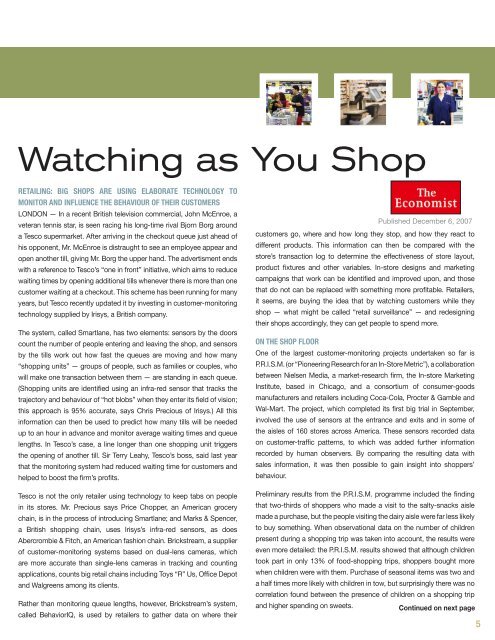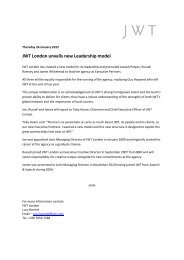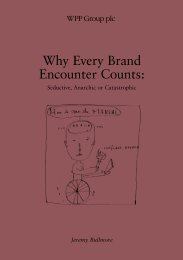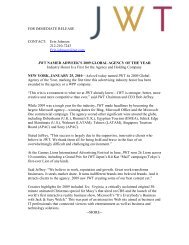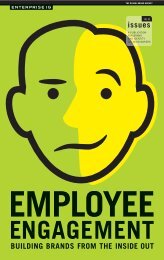the impending in-store marketing revolution - WPP.com
the impending in-store marketing revolution - WPP.com
the impending in-store marketing revolution - WPP.com
Create successful ePaper yourself
Turn your PDF publications into a flip-book with our unique Google optimized e-Paper software.
Watch<strong>in</strong>g as You ShopRetail<strong>in</strong>g: Big shops are us<strong>in</strong>g elaborate technology tomonitor and <strong>in</strong>fluence <strong>the</strong> behaviour of <strong>the</strong>ir customersLONDON — In a recent British television <strong>com</strong>mercial, John McEnroe, aveteran tennis star, is seen rac<strong>in</strong>g his long-time rival Bjorn Borg arounda Tesco supermarket. After arriv<strong>in</strong>g <strong>in</strong> <strong>the</strong> checkout queue just ahead ofhis opponent, Mr. McEnroe is distraught to see an employee appear andopen ano<strong>the</strong>r till, giv<strong>in</strong>g Mr. Borg <strong>the</strong> upper hand. The advertisment endswith a reference to Tesco’s “one <strong>in</strong> front” <strong>in</strong>itiative, which aims to reducewait<strong>in</strong>g times by open<strong>in</strong>g additional tills whenever <strong>the</strong>re is more than onecustomer wait<strong>in</strong>g at a checkout. This scheme has been runn<strong>in</strong>g for manyyears, but Tesco recently updated it by <strong>in</strong>vest<strong>in</strong>g <strong>in</strong> customer-monitor<strong>in</strong>gtechnology supplied by Irisys, a British <strong>com</strong>pany.The system, called Smartlane, has two elements: sensors by <strong>the</strong> doorscount <strong>the</strong> number of people enter<strong>in</strong>g and leav<strong>in</strong>g <strong>the</strong> shop, and sensorsby <strong>the</strong> tills work out how fast <strong>the</strong> queues are mov<strong>in</strong>g and how many“shopp<strong>in</strong>g units” — groups of people, such as families or couples, whowill make one transaction between <strong>the</strong>m — are stand<strong>in</strong>g <strong>in</strong> each queue.(Shopp<strong>in</strong>g units are identified us<strong>in</strong>g an <strong>in</strong>fra-red sensor that tracks <strong>the</strong>trajectory and behaviour of “hot blobs” when <strong>the</strong>y enter its field of vision;this approach is 95% accurate, says Chris Precious of Irisys.) All this<strong>in</strong>formation can <strong>the</strong>n be used to predict how many tills will be neededup to an hour <strong>in</strong> advance and monitor average wait<strong>in</strong>g times and queuelengths. In Tesco’s case, a l<strong>in</strong>e longer than one shopp<strong>in</strong>g unit triggers<strong>the</strong> open<strong>in</strong>g of ano<strong>the</strong>r till. Sir Terry Leahy, Tesco’s boss, said last yearthat <strong>the</strong> monitor<strong>in</strong>g system had reduced wait<strong>in</strong>g time for customers andhelped to boost <strong>the</strong> firm’s profits.Tesco is not <strong>the</strong> only retailer us<strong>in</strong>g technology to keep tabs on people<strong>in</strong> its <strong>store</strong>s. Mr. Precious says Price Chopper, an American grocerycha<strong>in</strong>, is <strong>in</strong> <strong>the</strong> process of <strong>in</strong>troduc<strong>in</strong>g Smartlane; and Marks & Spencer,a British shopp<strong>in</strong>g cha<strong>in</strong>, uses Irisys’s <strong>in</strong>fra-red sensors, as doesAbercrombie & Fitch, an American fashion cha<strong>in</strong>. Brickstream, a supplierof customer-monitor<strong>in</strong>g systems based on dual-lens cameras, whichare more accurate than s<strong>in</strong>gle-lens cameras <strong>in</strong> track<strong>in</strong>g and count<strong>in</strong>gapplications, counts big retail cha<strong>in</strong>s <strong>in</strong>clud<strong>in</strong>g Toys “R” Us, Office Depotand Walgreens among its clients.Ra<strong>the</strong>r than monitor<strong>in</strong>g queue lengths, however, Brickstream’s system,called BehaviorIQ, is used by retailers to ga<strong>the</strong>r data on where <strong>the</strong>irPublished December 6, 2007customers go, where and how long <strong>the</strong>y stop, and how <strong>the</strong>y react todifferent products. This <strong>in</strong>formation can <strong>the</strong>n be <strong>com</strong>pared with <strong>the</strong><strong>store</strong>’s transaction log to determ<strong>in</strong>e <strong>the</strong> effectiveness of <strong>store</strong> layout,product fixtures and o<strong>the</strong>r variables. In-<strong>store</strong> designs and market<strong>in</strong>gcampaigns that work can be identified and improved upon, and thosethat do not can be replaced with someth<strong>in</strong>g more profitable. Retailers,it seems, are buy<strong>in</strong>g <strong>the</strong> idea that by watch<strong>in</strong>g customers while <strong>the</strong>yshop — what might be called “retail surveillance” — and redesign<strong>in</strong>g<strong>the</strong>ir shops accord<strong>in</strong>gly, <strong>the</strong>y can get people to spend more.ON THE SHOP FLOOROne of <strong>the</strong> largest customer-monitor<strong>in</strong>g projects undertaken so far isP.R.I.S.M. (or “Pioneer<strong>in</strong>g Research for an In-Store Metric”), a collaborationbetween Nielsen Media, a market-research firm, <strong>the</strong> In-<strong>store</strong> Market<strong>in</strong>gInstitute, based <strong>in</strong> Chicago, and a consortium of consumer-goodsmanufacturers and retailers <strong>in</strong>clud<strong>in</strong>g Coca-Cola, Procter & Gamble andWal-Mart. The project, which <strong>com</strong>pleted its first big trial <strong>in</strong> September,<strong>in</strong>volved <strong>the</strong> use of sensors at <strong>the</strong> entrance and exits and <strong>in</strong> some of<strong>the</strong> aisles of 160 <strong>store</strong>s across America. These sensors recorded dataon customer-traffic patterns, to which was added fur<strong>the</strong>r <strong>in</strong>formationrecorded by human observers. By <strong>com</strong>par<strong>in</strong>g <strong>the</strong> result<strong>in</strong>g data withsales <strong>in</strong>formation, it was <strong>the</strong>n possible to ga<strong>in</strong> <strong>in</strong>sight <strong>in</strong>to shoppers’behaviour.Prelim<strong>in</strong>ary results from <strong>the</strong> P.R.I.S.M. programme <strong>in</strong>cluded <strong>the</strong> f<strong>in</strong>d<strong>in</strong>gthat two-thirds of shoppers who made a visit to <strong>the</strong> salty-snacks aislemade a purchase, but <strong>the</strong> people visit<strong>in</strong>g <strong>the</strong> dairy aisle were far less likelyto buy someth<strong>in</strong>g. When observational data on <strong>the</strong> number of childrenpresent dur<strong>in</strong>g a shopp<strong>in</strong>g trip was taken <strong>in</strong>to account, <strong>the</strong> results wereeven more detailed: <strong>the</strong> P.R.I.S.M. results showed that although childrentook part <strong>in</strong> only 13% of food-shopp<strong>in</strong>g trips, shoppers bought morewhen children were with <strong>the</strong>m. Purchase of seasonal items was two anda half times more likely with children <strong>in</strong> tow, but surpris<strong>in</strong>gly <strong>the</strong>re was nocorrelation found between <strong>the</strong> presence of children on a shopp<strong>in</strong>g tripand higher spend<strong>in</strong>g on sweets.Cont<strong>in</strong>ued on next page5


